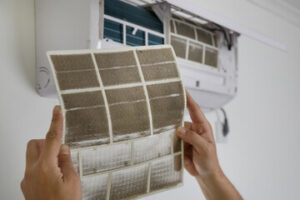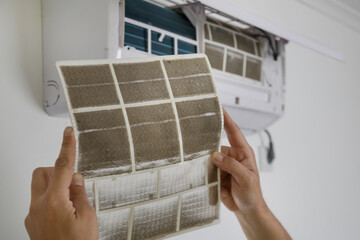If you are unsure how to replace your filter, your service tech will be happy to demonstrate the process. He will show you where the filter is located, and how to remove the old one and insert the new one.
It is also a good idea to keep the dimensions of the old filter handy, as it will help you find a replacement that fits correctly. Call All Temp Air Conditioning & Refrigeration experts for professional service.
 How To Replace Your Air Filter
How To Replace Your Air Filter
The first thing you need to do is locate the filter. This may take a little sleuthing. You might have to walk around the house or even go outside and look through some bushes or trees. Then, you need to gather all the tools and materials. This includes a new air filter that matches the existing one, safety goggles or gloves, and a vacuum cleaner to clean off any dust particles still stuck on the old filter.
You should also make sure that you are shutting off any breakers connected to your system, or gas lines (if applicable). This will prevent electrocution or fires as you work.
Next, you need to remove the old filter. It should be attached to a hinged or removable cover, which is typically held in place with some screws. Some filters have a small arrow on the frame that indicates the direction that the airflow should be. Make note of this when you replace the new filter to ensure that it is installed correctly.
Now you need to install the new filter. This is probably the easiest part of the process, but you need to make sure that the filter is the right size. Some filters have a printed chart on the side that gives the size in inches, but others might have the sizing listed as “nominal” or something similar. If you’re unsure about the size of your filter, contact a professional.
Locate the Filter
Taking the time to change out your filter is a crucial task for keeping your system running smoothly. Air filters help trap dust and other contaminants that can clog up the system, which increases wear and tear on important parts and cuts down on efficiency. Thankfully, changing out your filter is a simple job that takes just minutes to complete.
First, make sure to turn off any power sources connected to the unit that you’re working on. This is an important safety precaution to prevent electrocution or fires. It also helps to ensure that any contaminants don’t get sucked into the system while you’re working on it.
Next, locate the filter and determine its condition. If it’s dingy or greyish, it’s time to swap out the old one for a new one. Some filters have arrows printed on them to indicate how they should be placed in the system, so make sure you follow these instructions.
Once you’ve found the filter, shut off power to the system again by switching off the breaker at the unit itself or using the switch located on/near the indoor component (often shaped like a light switch). Then, remove the cover of the return vent and pull out the old filter. If you have a pleated filter with thin metal wiring on one side, make sure the side without the wiring is facing up to avoid blocking airflow through the system.
Remove the Old Filter
Before you can replace the filter, you need to remove the old one. The exact way to do this varies depending on your air conditioning system type. But in general, you will need to turn off the system before removing the cover or grille (if there is one). Then find your filter—usually near the return vent where the air gets sucked into the AC—and open its cover. If the filter looks clogged, it’s time to change it.
You can usually spot a disposable filter by the cardboard frame it’s housed in, which may have a pleated or ribbed surface. The cover should snap open and you’ll be able to pull it out easily. Seal the old filter in a plastic bag before discarding it so contaminants don’t escape.
If you have a reusable filter, you’ll need to gently rinse it with a faucet or spray bottle using a low stream of water. If the filter is caked in dust and other debris, washing it with high-pressure water can damage the fibers. Then let the filter dry completely before reinstalling it in your system. You’ll need to align it correctly by looking for arrows that indicate which direction air flows and making sure the filter fits snugly inside. When it’s ready, reinsert the filter and close the cover or grate. If you’re replacing a furnace filter, read the manufacturer’s instructions for proper installation.
Install the New Filter
It’s a good idea to purchase an air filter with the same dimensions as your old one — a filter that is too large can cause gaps around the vent, which allows harmful dust particles to pass through and burn up your system. If you’re not sure what size to purchase, a home warranty plan contractor can help.
First, make sure the unit is off and unplugged before attempting to remove the filter. This is for your safety and the safety of your equipment. If it is running while you’re removing the clogged filter, dust can be sucked into your system, which can damage it or prevent it from working properly.
Once you’ve figured out where your filter is located, it should be easy to remove. You may need to clean the cover or grille before reinstalling it, as filters tend to collect a lot of dust. You should also check the airflow direction, which is usually indicated by arrows on the frame of the filter — the arrows should be pointing away from you and toward your AC system.
Once you have a new filter installed, it’s a good idea to write the date on the corner so you can remember when to replace it. Some homeowners prefer to sign up for a service that ships them replacement filters at one-, two, or three-month intervals. Others choose to keep track of their replacement schedule, using a calendar or other reminder tool.
Replace the Cover or Grille
If the grate that covers your filter is caked with dust, it’s time to change the filter. In addition to being a sign that it’s time to replace, a dirty filter restricts airflow and can strain your AC.
Unscrew the grate or open the latch on your return air vent and pull out the old filter. Dispose of it in the trash. You can also clean the air vent grille and grate before installing the new filter. A damp cloth is usually sufficient. Make sure you close the latch on the air vent register and turn the system back on when you’re finished.
Before putting in the new filter, examine it for proper alignment. Most filters have arrows printed on them that indicate which way they should face. In most cases, you should insert the new filter so that the arrows point toward the ductwork that draws in air.
Then, install the filter and screw or latch the grate back into place. Before turning the system on, write the date on the edge of the filter or somewhere else so you can remember when it was changed last. You may want to consider signing up for a service that ships you replacement filters at one-, two, or three-month intervals. That way, you’ll never have to worry about forgetting to change the filter. And, it’s a lot less expensive than hiring someone to do the job for you.
Turn on the System
If the coronavirus pandemic has you feeling nervous about virus particles entering your home, a high-efficiency filter might be a wise investment. These filters typically have a higher MERV rating than standard ones, which helps to trap the tiny particles that can cause respiratory problems.
As you install the new filter, make sure it’s a snug fit. If it’s too loose, air contaminants will bypass the filter and clog your system. It’s also important to use a filter that matches your HVAC unit and type of system. Refer to the manufacturer’s site or your owner’s manual for guidance on selecting the correct size filter for your unit.
After the new filter is installed, turn your air conditioner back on. You’ll notice a gentle hum from the machine indicating that the unit is working properly.
If you have a washable filter, be sure to follow its maintenance instructions for cleaning and drying. A poorly maintained reusable filter can attract mold and mildew, which is then expelled into the air your family breathes.
